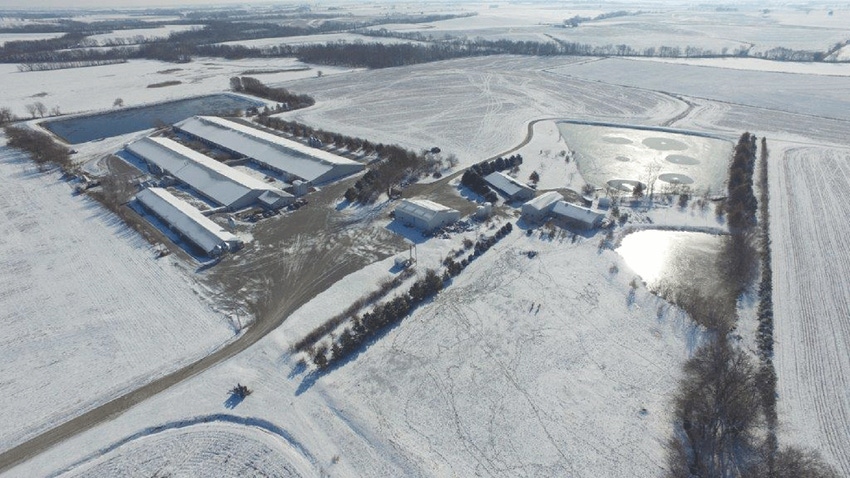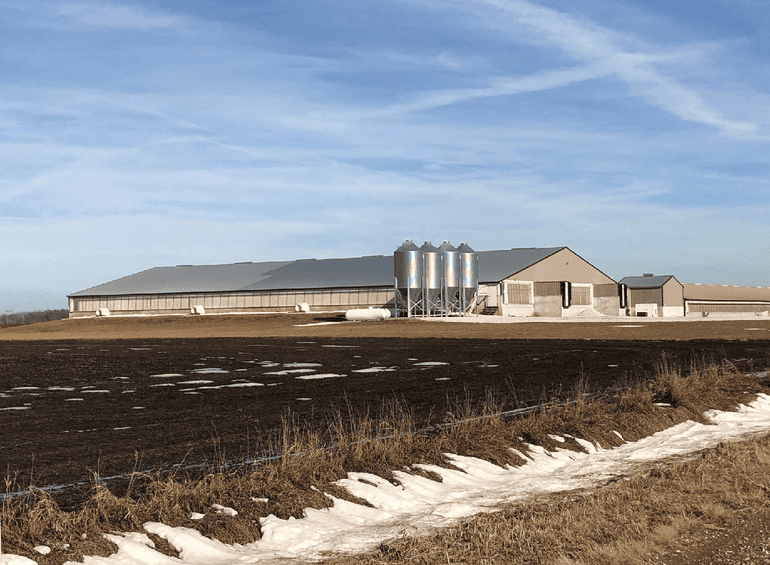Once an Environmental Steward, always a steward.

From 1994 through 2014, the National Pork Board recognized some of the industry’s most progressive producers in environmental management.
Green before being green was even popular, these producers implemented some of the most environmentally friendly manure management systems, water and soil conservation practices, odor-control strategies, farm aesthetics, neighbor relations and wildlife habitat promotion. Farms such as Iowa Select, Schwartz, Wakefield, Future View and Maken Bacon are just a handful of the more than 80 recipients that have proudly held the title of Environmental Steward.
However, as the 2014 class can attest, once stewardship becomes part of the business plan, it’s there to stay. While Wessling Ag and Stephens Farm have undergone some changes in the last five years, both farms have remained vigilant in their environmental initiatives.
A warm welcome
Since 2014, Wessling Ag has welcomed a daughter back to its Grand Junction, Iowa, farm, added 2,400 pigs to the now-10,000 feeder-to-finish operation and transitioned to a power-ventilated system — but that hasn’t slowed down the efforts to maintain soil, water and air quality. This spring the family will be busy planting trees around the new site one of the Wesslings’ daughters is running.
“The trees have helped with the appearance of the farm and also help with wind flow,” says Bruce Wessling, Wessling Ag’s owner.
The first farm owners to sign up for the Iowa Green Farmstead Partner program, Bruce and his wife, Jenny, have developed a vegetative environmental buffer around their farm. The system not only adds to the aesthetics of the site, but also can reduce particulate matter and odor effects by up to 90%.
The Wesslings have also extended their buffer system beyond the barns to their 4,600 acres of corn and soybeans. Since winning the award, the family has added several grass waterways and established buffer strips along creeks to reduce soil erosion and runoff from crop acres.
“Any farm we have with a creek through it now has a nice little buffer strip,” Wessling says. “We just think that is a good practice, and helps keep the soil from eroding close to the creek and helps trap the runoff. That is one thing we have been pretty sold on.”
Wessling says the biggest environmental initiative they have adopted in the last five years, however, has been cover crops.
“That is catching a lot of publicity right now as far as water quality. We have been experimenting with cover crops for the last three years now,” Wessling says. “I’m not saying it’s something I’m going to do 100%, but we are trying it, and trying to see how it works in our operation at this point.”
Wessling Ag has also been testing out some new pit additives and manure application technology. Using wet-dry feeders to reduce water waste and increase manure value on a per-gallon basis, the Wesslings take steps to ensure proper nutrient placement, which is achieved through sampling and manure incorporation in accordance with their manure management plan.
“We are able to do applied maps and turn around and run the yield monitor on the combine, and can tell whether that practice improved yield or not,” Wessling says. “I think we gained a lot there the last five or six years of the feasibility of being able to run some trials on different practices, as far as our manure application goes.”
With water quality and nuisance concerns from the community often accompanying a new site being built, the Wesslings aren’t shy about the extra environmental initiatives they have implemented on their farm. This past summer they were one of three Greene County farms that participated in an Iowa Pork Producers Association farm tour for local county officials and supervisors. The event was held just before the election, and some of the candidates that were running were in attendance.
“We had a good turnout, and I think doing those things in the community shows the importance of pork production,” Wessling says. “I think there has been a lot of false and emotional information put out at those council meetings, so that was kind of our way of trying to combat that, and give them [politicians] some facts to base some decisions on and to show that there are a lot of good people in the community that raise pork. We’re all raising our families in the same area and drinking the water, and we want the best for our families, too.”

Since receiving the 2014 Environmental Steward award, Wessling Ag has welcomed daughter Jolee back to the Grand Junction, Iowa, farm and put up a new barn for 2,400 pigs.
Before putting up a new barn, Wessling encourages pork producers to do some homework. The family turned to the Coalition to Support Iowa’s Farmers to go through the necessary rules and regulations that must be met to build a hog barn. Understanding prevailing winds and how they can impact odor movement also is important when choosing a site for a new livestock facility. CSIF guided the family using the Community Assessment Model, a site-specific tool developed by Iowa State University, that can help identify potential odor issues with proposed sites.
The Wesslings also visited neighbors to answer any questions about the proposed construction. In the end, the family was able to build the barns without confrontation or public criticism.
They continue to communicate with neighbors today.
“I think as long as you are doing everything the way you should, there’s not a lot people can complain about, if you are abiding by your manure management plan and trying to be courteous of your neighbors,” Wessling says. “If you are going to build a barn, there’s probably good places to build them, and there’s probably poor places to build them. Keep that in mind when you are going to place a barn — that you want to be a good neighbor.”
While the family was fortunate to have daughter Jolee join the business, Wessling says he hopes more young people consider coming back to the farm.
“I think there are a lot of opportunities in agriculture, and I would encourage young people to take a look at agriculture and pork production — and to come back to the family farm,” Wessling says.
No rest for the weary
David Stephens is hoping for a little breather at his Saline County, Mo., farm. Between putting in gestational pens and electronic sow feeders, and adding milk decks and gilt developing units at the family’s sites, the last five years have been nothing short of a roller coaster for the 2014 Pork Industry Environmental Steward.
“When you start doing those kinds of changeovers, there are a lot of things that have to be relearned,” Stephens says. “It hurt production for a while; that’s not saying we are not back up and hitting production strongly again.”
Stephens and his wife, Sharon, along with three of their children, are contract farrow-to-wean growers for JBS and produce about 190,000 pigs per year. They also raise 600 acres of corn and soybeans on adjacent land. First recognized for their tunnel-ventilated sow barns, solar-panel energy system and shallow-pit manure storage when they received the 2014 award, the Stephenses have remained steadfast in their stewardship practices — even with all the changes going on around the farm.
Stephens has upgraded to higher-volume equipment and uses bigger hoses now in his manure management program. He still operates a remote-controlled lagoon boat to agitate the contents of his manure pit for a uniform flow of nutrients to pump out on his fields, but now it’s all run through GPS.
“We can set up a perimeter, and it automatically runs its course,” Stephens says. “You can keep it stirring all day long if you want to.”
The free-standing and roof-mounted solar units he’s placed on or around his house, employee homes and shop have paid for themselves, with rebate and tax credits. The farm is also saving some energy on hog barns with the 25-kilowatt system, but Stephens says it doesn’t make too much of a dent, since the barns use anywhere from 2,500 to 3,000 kW a day.
The trees that were planted around the sow sites, with the help of the Natural Resources Conservation Service, have all come in nicely now. They draw remarks from passers-by on how nice the homestead looks, in addition to the odor control they provide. The 4-H and FFA members his wife brings out to the farm still come in and rave about how beautiful the place is.
The environmental initiatives the Stephenses have implemented on their sites are almost second-nature now, so when they had to make other changes on the farm, they could focus their efforts there.
Getting rid of gestational stalls and going to pens with an electronic sow feeding system was one of those changes that made it interesting. At one point in the installation, the crew found that what worked for one site was not necessarily going to work at another.
“We start changing one barn over to gestational pens. We actually had the barn almost 50% converted over, and we walked through it and discussed it, and it was like we’re going backwards,” Stephens says. “We’re creating a disaster, so we turned around and ordered Gestal 3G equipment and put all feeding stations in that building. We had no intention of doing that — and within two hours later, it was decided yes, we do need to do that, and we had them ordered, and it was coming to us.”
Stephens says when it comes to incorporating new technology, it’s sometimes best to take a step back and evaluate.
“Are we truly where we need to be?” Stephens says. “Or do we need to stop and put the brakes on and not go the wrong direction, even if we are going to have to waste a bunch of stuff to get ourselves back in the right direction?”
What’s next for the Stephens farm? The 2014 Environmental Steward says he hopes to ease his way out of the business slowly. After all, he’s been in it for over 50 years.
“I have enjoyed it. My wife calls me a workaholic — but if you can enjoy work, it’s not work,” Stephens says. “I feel like I have had an enjoyable life.”
About the Author(s)
You May Also Like





